New Meditation Huts Near Mt. Adams
Available for All Practitioners
Written by: Rev. Kozen Sampson

Six huts are already completed, ready for practitioners’ use.
Photos by: Mt. Adams Zen Temple
Mt. Adams Zen Buddhist Temple, nestled at the base of Washington’s Mt. Adams, in September completed six of its planned eight meditation huts.
The huts, next to a wooded hillside, are available for practitioners of any Buddhist tradition, as well as for people from other traditions wishing for a period of secluded contemplation.
Completion of the first six huts is a significant step in the fulfillment of Mt. Adams Zen Buddhist Temple’s long-rang plan, which includes an organic farm, the huts, a full set of practice materials, and construction of a temple.
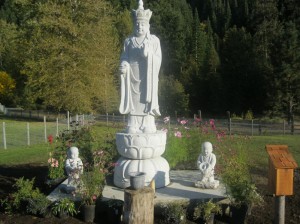
A Kwan Yin statue, representing compassion, watches over Mt. Adams Zen Center.
Already the huts are being used. About his retreat one local Christian minister said, “It is just God and me in the hut – we seem to work it all out.”
Ordained clergy of any faith are welcome to use the meditation huts free of charge. Lay people can also arrange to use a hut, for a small donation.
The huts are designed for individual meditation and retreat, and were built in The Cloister, an area enclosed by fence walls. Each hut has a small altar inside dedicated to a specific Buddha or Bodhisattva, and each comes with a small pad, a flat cushion, a thick round sitting pillow, a clock and a small ceramic heater.
The huts are very well insulated and stay warm and toasty in the winter, as well as cooler in the summer.
Sangha members are completing the cloister’s landscaping, and shower and restroom facilities are located just outside the cloister area.
Five of the huts measure 8 feet square, with two windows and a small ceramic heater. One meditation hut was designed for people with mobility challenges, and meets requirements of the Americans with Disabilities Act. It is larger than the other huts.
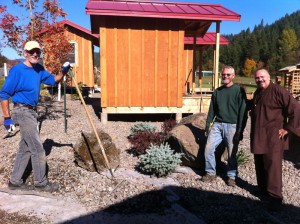
Chuck Foster, Dave Hanken, and teacher Ron Zimmerman, working on the Mt. Adams temple grounds.
All of the huts are heavily insulated, environmentally sensitive, green built, free of volatile organic compounds, and made of local wood and other products whenever possible.
A well-stocked commercial kitchen, shower and restroom facilities are a short distance from the cloister area.
For large groups we recommend a dedicated cook from their organization. For individual retreats we can provide a noon meal plus fruit, milk, or juice for morning and evening nutrition, or people can cook their own meals. Coffee and tea are always available.
We will have a composting toilet in the cloister area by May 2014.
The patron of the cloister is Ksitigarbha bodhisattva (also known as Earth Treasury, Dia Tang, Jizo), an 8-foot granite statue on a lotus pedestal. Ksitigarbha is known as the patron of all beings in hell, as well as travelers, firefighters and all children who die before their parents.
He is one of the best-liked bodhisattvas across much of Asia. In keeping with tradition the Mt. Adams temple even provides free food and first aid supplies to hikers on the nearby Pacific Crest Trail, under a small shrine of Ksitigarbha.
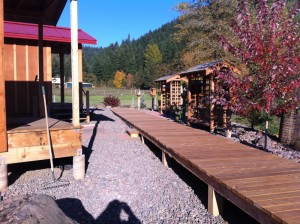
The huts are surrounded by harmonious grounds and gardens.
A line of small shrines with Buddhas face into the cloister area, along the inside of the fence.
“Our goal is to have 1,000 Buddhas. Currently we’re at 50 and it seems quite crowded,” said Thich Minh Tinh, the temple’s resident monk. “There is a folk story in the Far East that says, ‘To look on the face of a Buddha statue causes our heart to open to the dharma.’”
Because of this tradition, some Buddhist centers have many Buddhas. Mt. Adams’ Buddha shrine collection was started by visitors, who give the center several Buddhas every year.
A row of three copper prayer wheels has also been donated to the cloister, and forms part of the internal pathway. A local artist, a metal worker, and a carpenter have created four additional large Tibetan-style prayer wheels. These wheels are being painted, and when completed will be on either side of the entrance to the cloister.
The temple also has a small bed and breakfast that can provide back-up space for families and people supporting retreatants. Travelers also often stay there. The entire facility is often rented out for group retreats by colleges or other organizations; It recently hosted 35 people for a three-sangha weekend-long retreat, sponsored by Northwest Dharma Association.
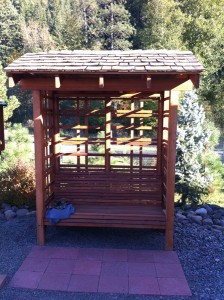
A bench is a good place for contemplation.
About the temple
Mount Adams Zen Buddhist Temple’s heritage is from the Vietnamese Zen school of Thich Thien An, a contemporary and schoolmate of the famous Vietnamese teacher Thich Nhat Hanh.
Meditation, devotion, and metta (loving kindness) are the three pillars of practice at the temple, where the schedule includes several meditation sessions each day. The focus is on daily practice, making each moment real and present.
“As Buddhism takes on its Western culture face, many of the ethnic pieces of practice become adapted, enhanced, dropped or modified,” said Thich Minh Tinh. “For Mahayana practitioners, the use of English may take over using many non-English words.”
The temple has several local members as well as people from Vietnamese, Chinese, Japanese, Tibetan and Thai ethnic origin, who visit regularly. One full-time monk resides at the center, while monks and priests come and stay in the summer.
Welcoming multi-ethnic visitors has been an adjustment for the temple, as gifts and customs are intertwined with the temple’s regular practice. The addition of prayer wheels, Pure Land Buddhist Practices (“Namo Amitofo”), tantric and Shingon practices have all added to the flavor, color and texture that the temple experiences.
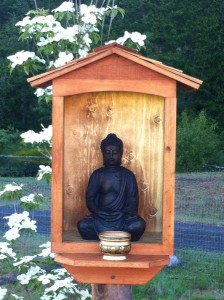
One of the Buddha statues in niches around the cloister.
The last development will be to build a small temple. The county planning council has already given permission for a temple, which hopefully is to be built sometime in the next few years. The center currently uses an existing second-floor apartment, in a historic 100-year-old barn, as a temporary temple.
Trout Lake is quite a small village with fewer than 500 year-round residents. It is wonderfully warm in the summer, covered in snow in the winter, and is blessed with the always-present snow-covered Mt. Adams (Pahto to the Indian population) and fresh clean air.
The Trout Lake valley is a primarily organic agriculture and organic dairy area. The drinking water is naturally one of the purest in the world, and smog and pollution are not evident. It is a perfect location for a Thien (Zen) temple.
